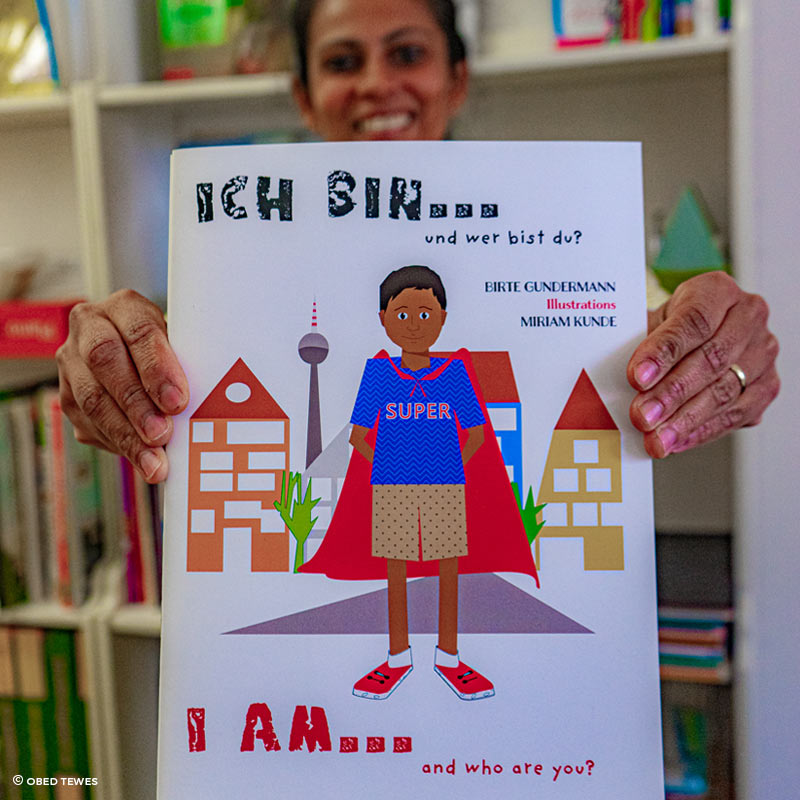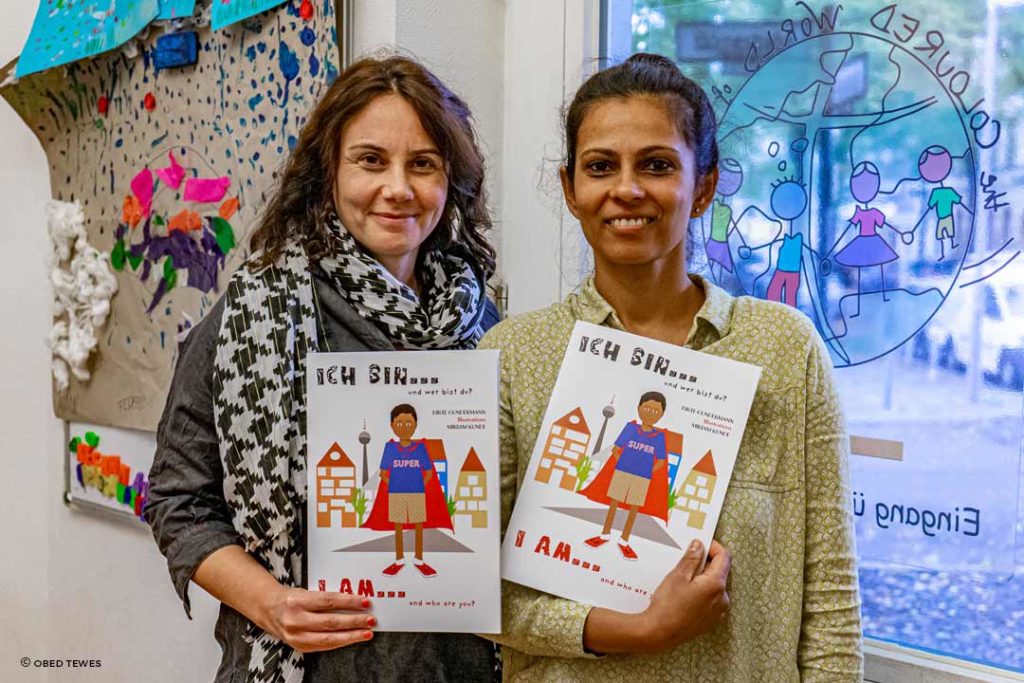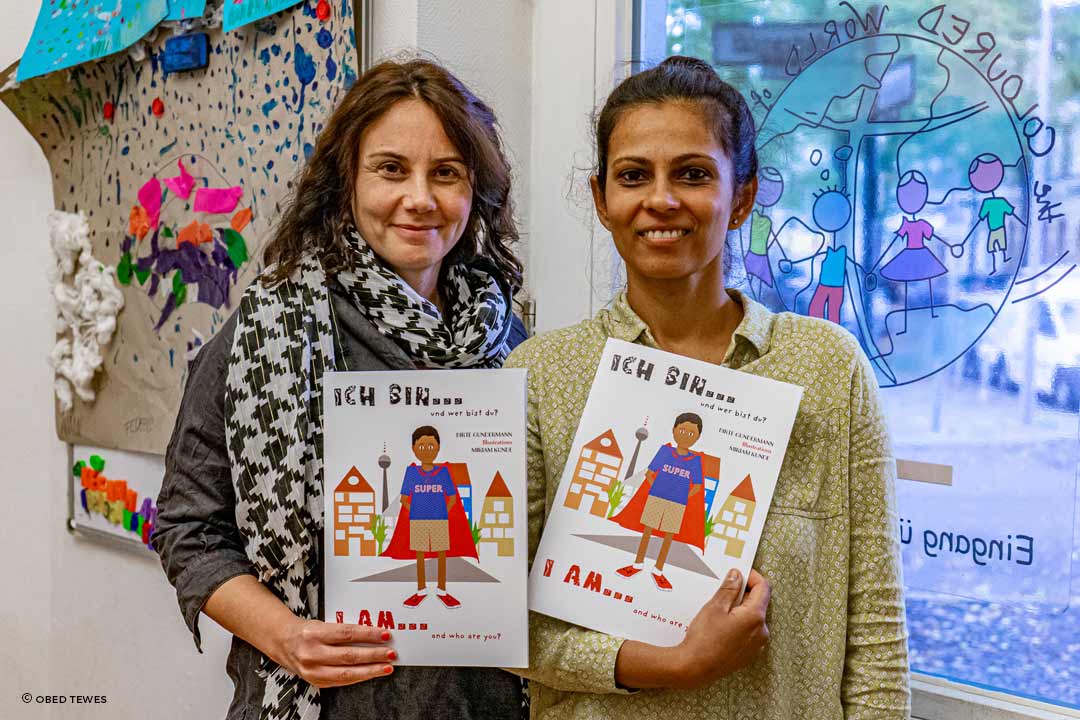I recently had the chance to catch up with Birte Gundermann and Mirian Kunde who’ve been running a kita (kindergarten in German) in Berlin called The Coloured World Of Kids for over eight years.
Last month they released their first book – Ich Bin… that follows Judah a boy who likes to talk about himself, his family, what he likes and about his life. It serves as a catalyst for kids to communicate with each other in a multi-cultural and multi-lingual world. So apt in today’s world!
ST: What inspired you to do this book together and come up with this concept?

“We chose this one multi-cultural family specifically because we felt it represented the kind of audience our book caters to.”
Miriam Kunde
Birte: It was because we are part of a Programe called “Sprachkita” (language kindergarten), it is funded by the german government and we receive support and money to do special projects and to stimulate quality in the kindergarten. We started this with this project…a book for the first words or expressions in german and since we are a bilingual kindergarten also in English.
Miriam: What also inspired us is ‘family’. We have many families here at the Kita that come and go, and each family has a story. This little boy Judah that we wrote about has his own little story as well. Each child has certain interests of their own, but there are also interests that include all children. Topics that all children are interested in, like “who am i?”, “who are you?”. So this has a social aspect, and obviously it’s also made in a way that helps children communicate and get’s them to talk about themselves.
ST: I noticed while going through the book that you have illustrated adults and children of different skin colour and I thought that was really cool because we don’t see that very often in books. Most often it’s only lighter skinned people represented. Was there a conscious decision made about this?
Miriam: Yes, i a way it was a conscious decision because those are the children we have here. Today we live in a multi-cultural world and children need to be able to see themselves in books to really take part in the whole story. To feel represented and included and be able to identify with the book.
So we chose this one multi-cultural family specifically because we felt it represented the kind of audience our book caters to as well.
ST: Nice! As a child, the first thing they are learning to do is communicate, and it’s nice to be able to understand the world with all it’s differences and be able to communicate well within all those differences, rather than say, “I’m only comfortable with a certain type of people”. That’s what struck me as I read the book was that communication is so vital, but it’s also vital within that communication to be able to be accepting of everyone with all our differences. This is an amazing project.
Birte: Yes, exactly…and it is so important that children start very early with it, with this diversity…variety and to learn very early on to find it very normal, especially in Berlin….it may be easier because we have so many cultures around us that we actually see it on the streets but for the german country it is very important that we start very early and it offers a big approach for the children because its a big issue…because the earlier we begin to find it normal and concentrate on the issue, it is the reality. We see this as a major responsibility and it is a big opportunity in this kindergarten which is bilingual, the whole um… formation of our goals is also an approach not only in German or English but also an approach to all languages that children bring with them and the families that meet here.

Miriam: It’s not just the diversity of the illustrations, but also the language. Children that come to our kita speak various languages at home and not necessarily German, and they want to feel included even with language and not have a barrier. Having a book that’s bilingual includes both sides.
I was recently due to visit a friend of mine who lives in a village in Germany and before I arrived she told me that when I arrive, people might be scared of my skin colour because they’ve never seen someone who is brown before! That really shocked my because I grew up in a world that was not like that! I grew up in Chennai, South India and my dad is white so I was always familiar with that. So I made it a point to send my friend copies of this book for all her kids because the last page has a picture of a person that can be coloured in. She wrote back to say that one of her kids had already read and coloured the page and same day it arrived.
ST: Speaking of children and colouring people, I’m reminded of my experience in India where in schools when children are asked to colour a drawing of people or themselves, they almost always with use the so called ‘skin tone crayon’ which is a light pink and represents European skin colour and not the browns that truly represent our brown skin. In fact colourism is so common and experienced at a very early age, that a child who has chocolate brown skin colour might represent themselves as light skinned.
I’d be interested to see how children colour the last page in your book. It will speak a lot about what they have already picked up from their environments and their perception of self and skin colour.
Birte: We have one child who is blonde and has blue eyes and has a friend whose parents come from South America…she draws herself with black hair and a darker skin tone because she thinks its so beautiful…and I think, that’s how it should be! Everyone should be able to choose what they think is nice and not what is forced on them from the outside,…what they are influenced to consider as aesthetically pleasing to them, from the society around them… whether it be from television or from politics.

